the place where Paleontology and Paleoanthropology meets Philately
Italy
Dinosaurs and other prehistoric animals, fossils, fossil-found places,
prehistoric humans, paleontologists, Charles Darwin on stamps and postmarks of Italy
| << previous country | back to index | next country >> |
Contents:
- Country overview
- Philately of Italy
- Official stamps of Italy related to Paleontology
- Other stamps of Italy to consider
- Commemorative postmarks of Italy related to Paleontology
- Other Commemorative postmarks of Italy to consider
- References
- Acknowledgements
Italy, officially the Italian Republic is a unitary parliamentary republic in Europe. with population of 61 million. Located in the heart of the Mediterranean Sea, Italy shares open land borders with France, Switzerland, Austria, Slovenia, San Marino and Vatican City. Italy covers an area of 301,338 km2 and has a largely temperate seasonal climate or Mediterranean climate; due to its shape, it is often referred to in Italy as lo Stivale (the Boot). [R1]
As Italy was not unified until 1861, its early postal history is tied to the various kingdoms and smaller realms that ruled in the peninsula.
Following the unification of Italy during 1860 and 1861, stamps in use in each of the territories that joined Italy were withdrawn from circulation and replaced with the stamps of the Sardinian kingdom. The transition took place in Modena, Parma and Romagna on February 1, 1860, in Naples on September 15, 1862 (although local authorities had previously printed stamps depicting the coat of arms of Savoy), and in the Papal States - only in 1870. Matraire's stamps were reprinted several times, and those printed after 17 March 1861 are usually considered the first stamps of the Kingdom of Italy. [R2]
Official stamps of Italy related to Paleontology and Paleoanthropology: prehistoric animals and humans, fossils and Charles Darwin
| 06.02.1988 "Remains of Isernia Man- Homo Aeserniensis" | 09.09.1996 "XIII International Congress on pre- and proto-history" [1] | 30.05.1998 "4th Intl. Convention on Fossils, Evolution and Environment" |
 |
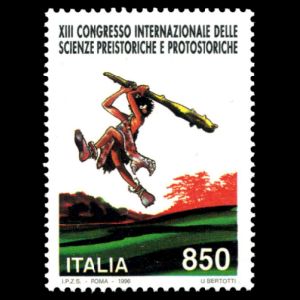 |
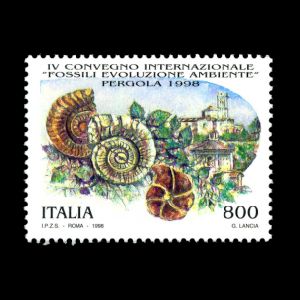 |
| 14.04.2000 "Tourism" [2] | 12.02.2009 "Charles Darwin" | 24.05.2021 "Treasures of the Alta Murgia National Park" |
 |
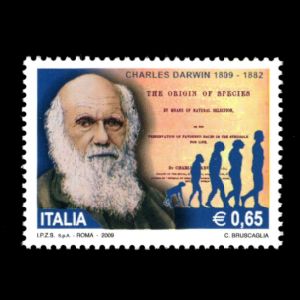 |

|
Notes:
[1]
- Prehistory means literally "before history". Human prehistory is the period from the time that behaviourally and anatomically modern humans first appear until the appearance of recorded history following the invention of writing systems. Since both the time of settlement of modern humans and the evolution of human civilizations differ from region to region, prehistory starts and ends at different moments in time, depending on the region concerned. [R8]
- Protohistory refers to a period between prehistory and history, during which a culture or civilization has not yet developed writing but other cultures have already noted its existence in their own writings. [R9]
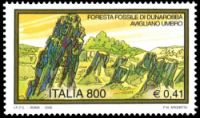 [2] One of the stamps shows petrified tree stumps from the fossilized forest of Dunarobba.
[2] One of the stamps shows petrified tree stumps from the fossilized forest of Dunarobba.The Petrified Forest is located in the village of Dunarobba, 2.5 km from the walls of Avigliano. Considered one of the most unique paleontological sites in the world, the trees remaining in this petrified forest are more than two million years old. The fossilization phenomenon that can be observed at this site is different from all other petrified forests because the trunks here were able to maintain their original consistency and erect position. The particular characteristics of this paleontological site make it a unique natural monument of great scientific importance. [R10]
Other stamps to consider
| 19.09.2001 "Discovery of Oetzi" [A1] | 24.07.2008 "Tourism" [A2] | 25.07.2015 "Dolomiti" [A2] |
 |
 |
 |
Notes:
[A1] Oetzi is a nickname given to the well-preserved natural mummy of a man, Homo sapiens sapiens, who lived around 3,300 BCE, (more precisely between 3359 and 3105 BCE), with a 66% chance that he died between 3239 and 3105 BCE. The mummy was found in September 1991 in the Oetztal Alps, hence the nickname "Oetzi", near the mountain of Similaun and Hauslabjoch on the border between Austria and Italy. He is Europe's oldest known natural human mummy, and has offered an unprecedented view of Chalcolithic Europeans. His body and belongings are displayed in the South Tyrol Museum of Archaeology in Bolzano, South Tyrol, Italy. [R6]
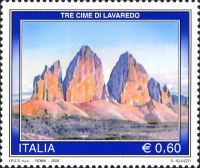
[A2] The Dolomites comprises a mountain range located in the northern Italian Alps.
A serial property of nine areas that present a diversity of spectacular landscapes of international significance for geomorphology marked by steeples, pinnacles and rock walls, the site also contains glacial landforms and karst systems.
It is characterized by dynamic processes with frequent landslides, floods and avalanches. The property also features one of the best examples of the preservation of Mesozoic carbonate platform systems, with fossil records. In August 2009, the Dolomites were declared a UNESCO World Heritage Site.
Commemorative postmarks related to Paleontology
| 195x "Sinclair" [PM] [DUN] [C1] | 1971 "Open Fossil museum in Bolca" [PM] | |
 |
 |
 |
| 09.07.1972 "Graphica'72 international philatelic show" [Sp] | 1977 "Giuseppe Scarabelli - politic and paleontologist" [PM] [C2] | 25.05.1980 "1st biennial international Fossil and Minerals fair" [Sp] |
 |
 |

|
| 06.09.1981 "6th philatelic trade show" [Sp] | 17.10.1981 "Antonio Stoppani" [Sp] [C3] | 29.11.1981 "VALPHIL'81 philately and numismatic trade show" [Sp] |
 |
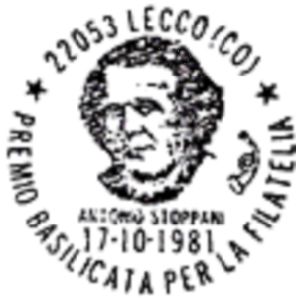 |
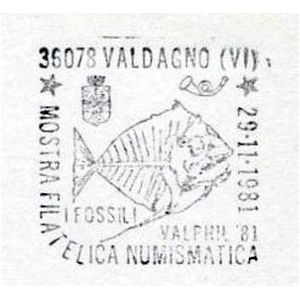
|
| 17.04.1982 "2nd Trade show - Minerals and Fossils" [Sp] - |
26.11.1983 "7th Fossil and Minerals fair in Toscana" [Sp] | 16.04.1983 "3rd Fossil and Mineral trade show" [Sp] |
 |
 |
 |
| 15.04.1984 "Philatelic show in Roma - First European" [Sp] | 16.03.1985 "Philatelic show in Torino - First European" [Sp] | 04.05.1985 "XIV Fossil and Mineral fair in Verona" [Sp] |
 |
 |
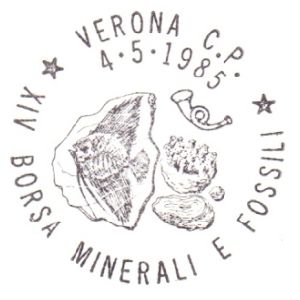
|
| 03.05.1986 "XV Fossil and Mineral fair in Verona" [Sp] | 04.10.1986 "3rd philatelic trade show - fossils and minerals" [Sp] - |
1988 "ACIOM S.P.A. company" [PM] |
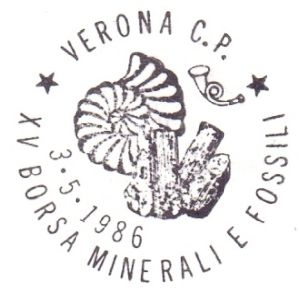
|
 |
 |
| 05.02.1988 "Paleontology fair" [Sp] - |
06.02.1988 "Philatelic show: Paleontology" [Sp] | 06.02.1988 "Homo aeserniensis" [FDC] |
 |
 |
 |
| 1988 "Philatelic show: Paleontology" [Sp] - |
22.04.1989 "XI Fossils and Minerals trade show - Lucca'89" [Sp] | 22.05.1989 "100th anniversary of Giuseppe Seguenza’s death" [Sp] |
 |
 |
 |
| 07.10.1989 "6th Fossils and Minerals trade show - A.V.I.S." [Sp] | 19.05.1990 "International symposium Ancient inhabitants of Europe" [Sp] | 24.04.1991 "Paleontologic show in Lucca" [Sp] - |
 |
 |
 |
| 1991 "Century of death of Antonio Stoppani" [Sp] [C3] - |
12.10.1991 "Century of death of Antonio Stoppani" [Sp] [C3] - |
10.12.1991 "Show the world of Dinosaurs" [Sp] |
 |
 |
 |
| 12.12.1993 "Show Dinosaurs of Jurassic Park" [Sp] | 22.10.1994 "8th philatelic show- Dinosaurs" [Sp] | 13.05.1995 "Philatelic show in Venosa - Venosa'95" [Sp] |
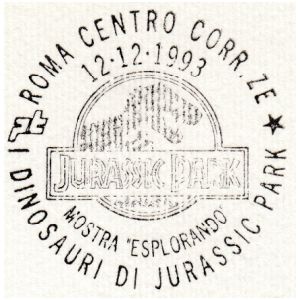 |
 |
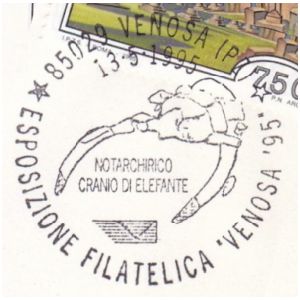 |
| 25.05.1996 "Mineral and Fossils fair in Imola" [Sp] | ||
 |
 |
|
| 09.09.1996 "XIII International Congress on Pre- and Proto-history" [FDC] [1] | 1996 "Fossil forest of Dunarobba - travel Umbria" [PM] [2] | 25.05.1997 "Philatelic exhibit in Scuola - Fossils, Evolution, Environment" [Sp] |
 |
 |
 |
| 22.04.1998 "Convention-seminar the Dunarobba fossil forest" [Sp] [2] | 30.05.1998 "4th International Convention on Fossils, Evolution and Environment" [FDC] | 12.09.1998 "Exhibition Paleontology in Philately" [Sp] |
 |
 |
 |
| 27.09.1998 "20th anniversary of Philatelic club in Lucca - Minerals and Paleontology" [Sp] | 01.04.2000 "Salon of collecting and museums in Ancona city" [Sp] | 14.04.2000 "Tourism" [FDC] [2] |
 |
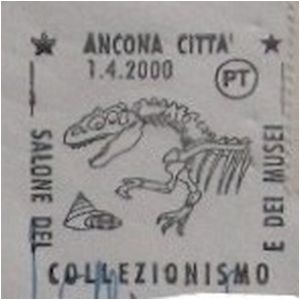 |
 |
| 29.04.2000 "Petrified forest of Dunarobba" [Sp] [2] | 06.05.2000 "29th trade show - Fossils and Minerals" [Sp] | 31.03.2001 "Salon of collecting and museums in Ancona city" [Sp] |
 |
 |
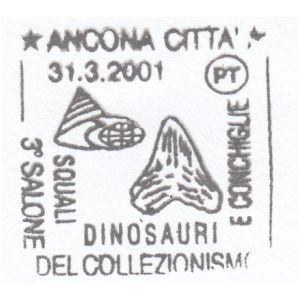 |
| 16.04.2001 "Olive and oil market show" [Sp] | 06.07.2001 "Regional stamp competition - VASTOPHIL 2001" [Sp] | 29.09.2001 "Cretaceous memories" [Sp] |
 |
 |
 |
| 31.05.2003 "Geo-Paleontology Museum of Lerici" [Sp] | 2003 "7th philatelic show MOLISEPHIL 2003 in Isernia" [Sp] | 08.05.2003 "Isernia La Pineta - canine of hippopotamus Paleolithic camp 736.000 years ago" [Sp] |
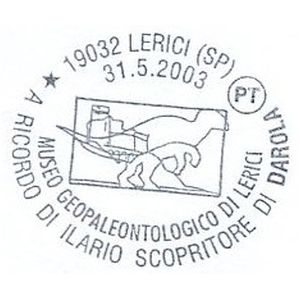
|

|

|
| 21.08.2004 "5th philatelic show - the mountains in philately" [Sp] | 05.10.2006 "Philatelic, numismatic and cartophilatelic exhibition" [Sp] | 29.09.2007 "inauguration of Paleontology museum in Borgosesia" [Sp] |

|
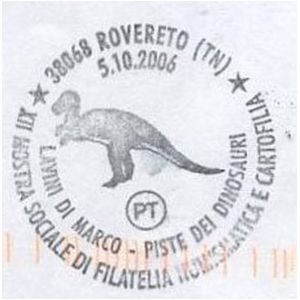
|
 |
| 20.10.2007 "inauguration of Geopaleontological museum Alto-Aventino in Palena" [Sp] | 01.12.2007 "8th philatelic-malacological exhibition - below and above the sea " [Sp] | 01.11.2008 "Freemasonry conference in Europe and the Mediterranean" [Sp] |
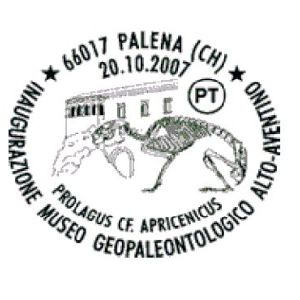 |
 |
 |
| 14.12.2008 "30th anniversary of Umbrian philatelic group - Mineralogy and Paleontology" [Sp] | 12.02.2009 "Charles Darwin" [FDC] [C4] | |
 |
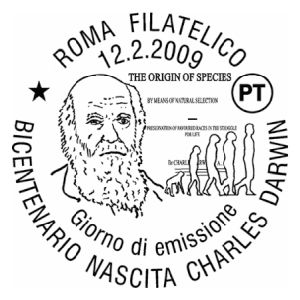 |
 |
| 04.05.2009 "Charles Darwin" [Sp] [C4] | 18.06.2009 "51st society symposium for the study of human biology" [Sp] | 23.06.2013 "Philatelic show - EPPAN 2013" [Sp] |
 |
 |
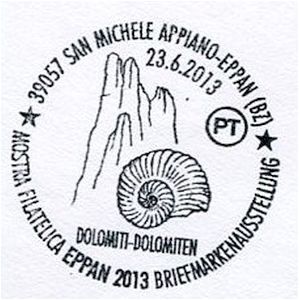
|
| 05.10.2013 "20th anniversary of discovery Altamura man" [Sp] [C5] | 10.12.2016 "30th anniversary of Municipal Archaeological Museum of the Toleriense Territory" [Sp] | 30.03.2017 "Inaguration of Altamura Man museum" [Sp] [C5] |
 |
 |
 |
| 04.07.2021 "Paleontologic festival in Vestananova" [Sp] | ||
 |
|
|
Notes:
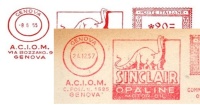 [C1] From the nineteen thirties until the fifties, the Sinclair Oil Company
depicted dinosaurs on their meter franking, as well as
regular advertisements
to advertise their motor oil.
They chose a dinosaur for a company logo as a symbol of the great length of time their
oil spent in the ground.
[C1] From the nineteen thirties until the fifties, the Sinclair Oil Company
depicted dinosaurs on their meter franking, as well as
regular advertisements
to advertise their motor oil.
They chose a dinosaur for a company logo as a symbol of the great length of time their
oil spent in the ground.The address of the company changed in 1957 – on the meter franking, the company replaced the street and house number with a post box number.:
"A.C.I.O.M. , C. POST. N. 1695, Genova" instead of "A.C.I.O.M., via Bozanno, 9, Genova"

[C2] Giuseppe Scarabelli (1820 - 1905) was a geologist, paleoethnologist and political Italian; he is remembered as the founder of Italian prehistoric archeology and was the first archaeologist to perform a stratigraphic excavation in Italy.
Scarabelli undertook systematic investigations concerning the position and age of the bones of some large mammals that inhabited the Imola Apennines in prehistoric times. Another innovative line of research, which gave him a leading role in the affirmation of geology and paleontology in Italy, was represented by the study of stone weapons collected there.
In 1850 he published the results of his research in the study Observations on ancient hard stone weapons that were collected in the Imola area, considered one of the first scientific contributions on Italian prehistory, with particular reference to objects of the Paleolithic and Neolithic. [R3]
[C3] Antonio Stoppani (1824 – 1891) was an Italian Catholic priest, patriot, geologist and palaeontologist. He was among the first to propose a geological epoch dominated by human activities that altered the shape of the land. He became professor of geology in the Royal Technical Institute of Milan and was distinguished for his research on the Triassic and Liassic formations of northern Italy.
Stoppani described several species of fossil molluscs while other fossil species have been named in his honour, including Fedaiella stoppanii Marini 1896 (a snail). Most of his collections are in the Museo di Storia Naturale, Milano, where he was responsible for constructing the building while he served as Director from 1882 to 1891. [R4]
 [C4] Many stamps and postmarks issued by Postal Authorities around the world in
2009 to commemorate both the 200th Anniversary or
bicentenary of the birth of the greatest naturalist in history, Charles Robert Darwin, and the 150th
Anniversary of the publication of his most famous work On the Origin of Species by Means of Natural Selection.
[C4] Many stamps and postmarks issued by Postal Authorities around the world in
2009 to commemorate both the 200th Anniversary or
bicentenary of the birth of the greatest naturalist in history, Charles Robert Darwin, and the 150th
Anniversary of the publication of his most famous work On the Origin of Species by Means of Natural Selection.
[C5] Commemorative postmark of "Altamura Man", shows reconstruction of its famous find made by Kennis & Kennis, which is on show at Altamura National Archaeological Museum, that located near the cave where the prehistoric skeleton of Altamura Man was found. The Altamura Man is a fossil of the genus Homo discovered in 1993 in a karst sinkhole in the Lamalunga Cave near the city of Altamura, Italy. Altamura Man is one of the most complete Paleolithic skeletons ever to be discovered in Europe. [R5]
Other commemorative postmarks of Italy to consider
| 1995 "XIII International Congress on pre- and proto-history" [Sp] [1] | 06.10.2007 "Paleontologic site Ciampate del Diavolo" [Sp] [Co1] | 01.10.2012 "40th anniversary of state scientific high school named Charles Darwin" [Sp] |
 |
 |
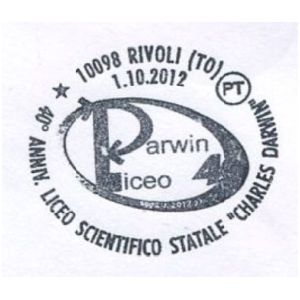 |
| 25.07.2015 "Dolomiti" [FDC] [A2] | 14.09.2019 "30th anniversary of football club of Carioca" [Sp] | |
 |
 |
 |
Notes:
[Co1] The Ciampate del Diavolo (Neapolitan: "Devil's Footprints" or "Devil's Trails") is a locality near the extinct Roccamonfina volcano in northern Campania, Italy. It is named after a set of fossilised hominid footprints preserved in pyroclastic flow deposits that have been dated to around 350,000 years ago. They have been attributed to bipedal hominids, possibly Homo heidelbergensis, which is known to have inhabited the region at the time. [R7]References:
- [R1] Italy: Wikipedia, WikiTravel, FlagCounter.
- [R2] Postal History and Philately of Italy:
Wikipedia,
Links to official website of the Post Authority, stamp catalog and a list of new stamps of Italy are here - [R3] Giuseppe Scarabelli: Wikipedia, Fontain Scarabelli
- [R4] Antonio Stoppani: Wikipedia
- [R5] The Altamura Man: Wikipedia
- [R6] Oetzi: Wikipedia
- [R7] Ciampate del Diavolot: Wikipedia
- [R8] Prehistory: Wikipedia
- [R9] Protohistory: Wikipedia
- [R10] Fossilized forest of Dunarobba: U#mbrian Travel
Acknowledgement:
- Many thanks to Miriam Mimmi Congedo, from Italy for her assistance in finding Italian postmarks and providing information about them.
- Many thanks to Dr. Peter Voice from Department of Geological and Environmental Sciences, Western Michigan University, for the draft page review and his valuable comments.
| << previous country | back to index | next country >> |